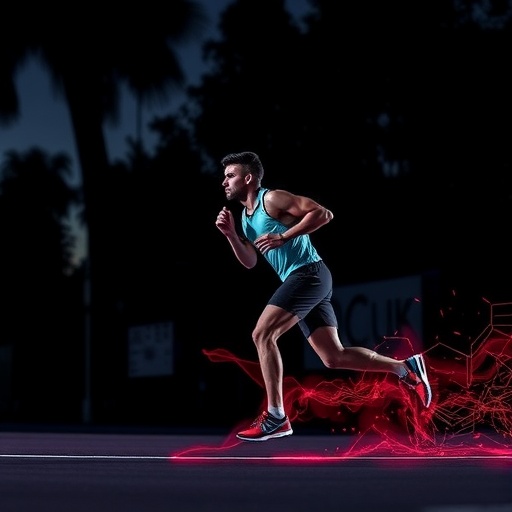Unlocking the unseen forces at play in running, researchers at Harvard John A. Paulson School of Engineering and Applied Sciences (SEAS) have harnessed the power of wearable sensor technology combined with advanced machine learning to accurately estimate the braking and propulsion forces generated during overground running. This breakthrough transcends traditional treadmill-bound studies, bringing biomechanics insights into the real-world environments where athletes train and compete, and opening new frontiers for injury prevention and performance enhancement.
At the core of this innovation lies the use of inertial measurement units (IMUs)—compact, commercially available sensors that track motion and orientation. While these sensors are embedded in many everyday devices such as smartphones and fitness trackers, their potential to quantify the physical forces acting on a runner’s body had remained untapped. Traditionally, precise measurement of ground-reaction forces required elaborate laboratory setups, including force plates integrated into treadmills or floors, limiting assessments to controlled environments. The Harvard SEAS team sought to bridge this gap by leveraging machine learning models trained on lab-collected data to extrapolate forces during outdoor runs.
This research was led by Lauren Baker, a postdoctoral scholar and avid runner, who developed a machine learning framework capable of interpreting the nuanced data from IMUs to predict horizontal forces—the braking forces that slow a runner upon foot strike and the propulsion forces that drive forward motion. These horizontal forces are critical components of running biomechanics, closely linked to running efficiency and injury risk, yet have rarely been the focus of studies that predominantly emphasize vertical forces associated with body weight and speed.
The inspiration partly stemmed from foundational work by Harvard evolutionary biologist Daniel Lieberman, who among other contributions, illuminated the biomechanical consequences of overstriding. Overstriding occurs when the foot lands excessively far ahead of the body’s center of mass, exacerbating braking forces that can increase injury risk. Lieberman’s earlier investigations, in collaboration with the Walsh lab, demonstrated that simple wearable devices could quantify braking and overstriding metrics, prompting inquiry into whether these devices could provide even deeper biomechanical insights.
In their experimental approach, the researchers equipped 15 volunteer runners with IMUs positioned on strategic locations including the hip and lower leg. Simultaneously, these participants ran on specialized laboratory equipment featuring treadmills and track segments embedded with force plates that directly measured the forces exerted on the ground. Machine learning algorithms were trained on this synchronized dataset to learn the intricate relationship between sensor readings, such as 3D accelerations and angular velocities, and the actual ground reaction forces measured by the force plates.
A key breakthrough was achieving a generalized predictive model that could infer braking and propulsion forces for runners outside the original training cohort, indicating the model’s robustness and adaptability. Remarkably, incorporating merely a handful of additional steps from a new runner allowed the system to fine-tune predictions, personalizing force estimations with heightened accuracy. This adaptability signals a path forward for individualized biomechanical monitoring that respects the unique gait characteristics of each runner.
To validate the model’s practical utility, the team conducted outdoor tests at the Harvard McCurdy Outdoor Track, outfitting five athletes with the same wearable sensors used in lab conditions. Even in the uncontrolled, variable environment of outdoor running, the model successfully predicted braking and propulsion forces using only the data from the inertial sensors. This accomplishment underscores the feasibility of deploying low-cost, portable sensor systems for real-time biomechanical analysis beyond laboratory confines.
The implications of this work extend far beyond academic curiosity. Braking and propulsion forces directly influence the stress experienced by muscles, tendons, and joints, making them crucial indicators of running form and injury risk. Existing consumer wearables provide a wealth of physiological and positional data but lack direct biomechanical force measurements. Integrating such force estimations into wearable products could empower runners with actionable feedback to adjust cadence, foot strike patterns, or posture to optimize performance while mitigating injury risks.
Looking ahead, the research team envisions refining sensor placement strategies to maximize data quality while minimizing hardware demands. There is also potential to integrate inertial sensor data with current smartwatch technologies for seamless monitoring and user-friendly feedback interfaces. Advanced machine learning promise to not only enhance force prediction accuracy but could also uncover novel biomechanical markers related to fatigue, recovery, or performance plateauing.
Moreover, this approach could catalyze breakthroughs in rehabilitation science beyond running. Similar sensor-machine learning paradigms have already shown promise in gait analysis among stroke survivors, and expanding to other locomotion-related clinical populations could revolutionize personalized physical therapy. The ability to non-invasively capture biomechanical forces in daily life environments represents a paradigm shift in how human movement health is monitored and managed.
As Conor Walsh, the Paul A. Maeder Professor of Engineering and Applied Sciences, notes, the current commercial wearable ecosystem measures fundamental metrics like step counts or heart rate but leaves a vast biomechanical landscape unexplored. Bridging this gap through validated sensor and AI technologies could redefine athlete monitoring, scientific research, and consumer health tracking alike.
In conclusion, this innovative convergence of wearable inertial sensors and machine learning heralds a new era in understanding human locomotion. By translating complex biomechanical forces from controlled labs to real-world running, these technologies open the door to smarter, safer, and more effective running experiences for athletes of all levels. As research progresses and device capabilities expand, the promise of personalized biomechanical insight is becoming an attainable reality.
Subject of Research: People
Article Title: Estimating braking and propulsion forces during overground running in and out of the lab
News Publication Date: 4-Sep-2025
Web References: PLOS One Article
References:
- Baker, L., Weigend, F. C., Swaminathan, K., Kim, D., Chin, A., Walsh, C., & Lieberman, D. E. (2025). Estimating braking and propulsion forces during overground running in and out of the lab. PLOS One. https://doi.org/10.1371/journal.pone.0330042
- Lieberman, D. E. et al. (2024). Wearable sensor-based studies of overstriding biomechanics. PubMed. https://pubmed.ncbi.nlm.nih.gov/38491093/
Image Credits: Eliza Grinnell / Harvard SEAS
Keywords: Human health, Biomechanics, Human locomotion, Machine learning, Physical exercise, Human physiology, Running biomechanics, Wearable sensors, Ground reaction forces, Overstriding, Propulsion forces, Braking forces




